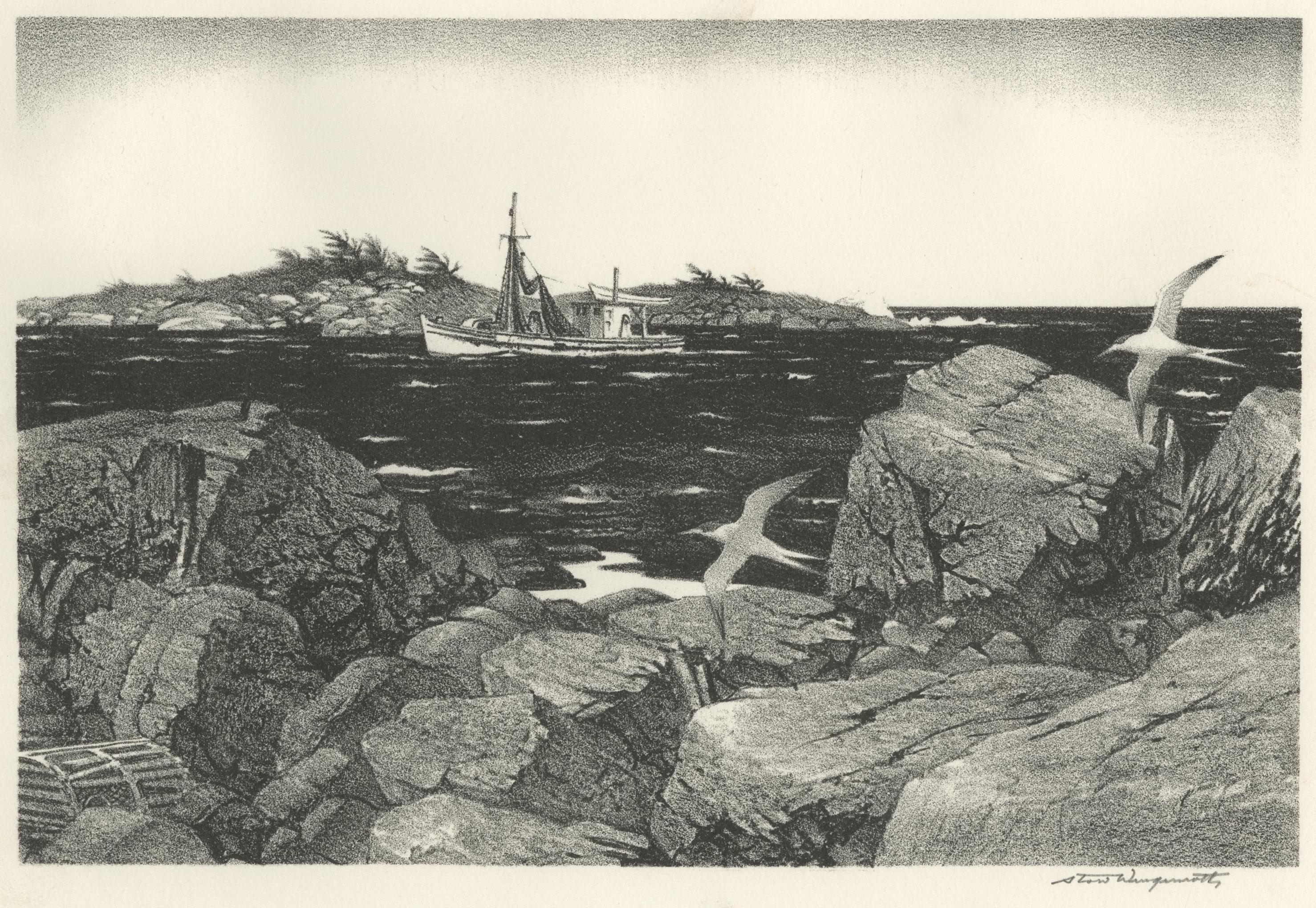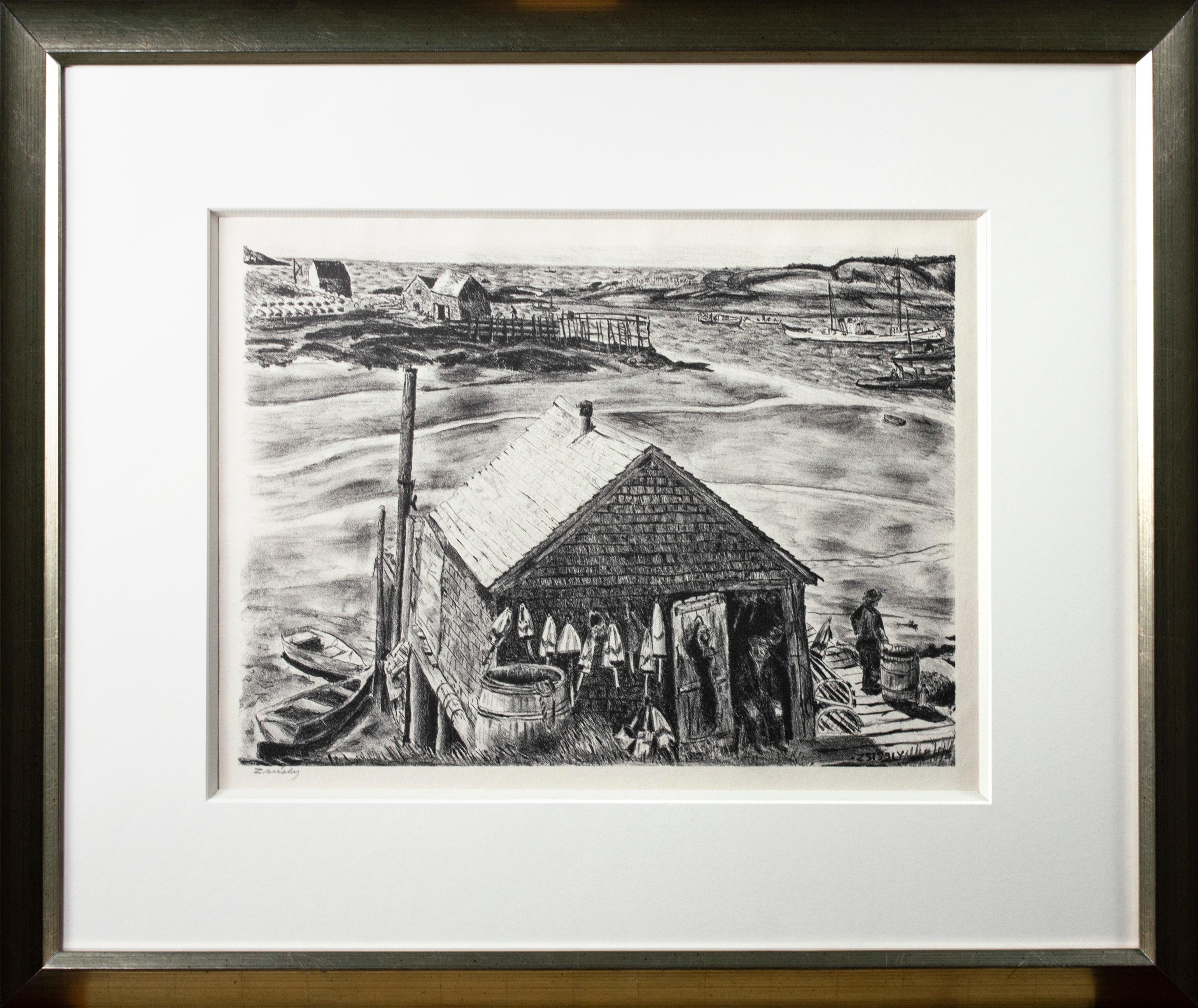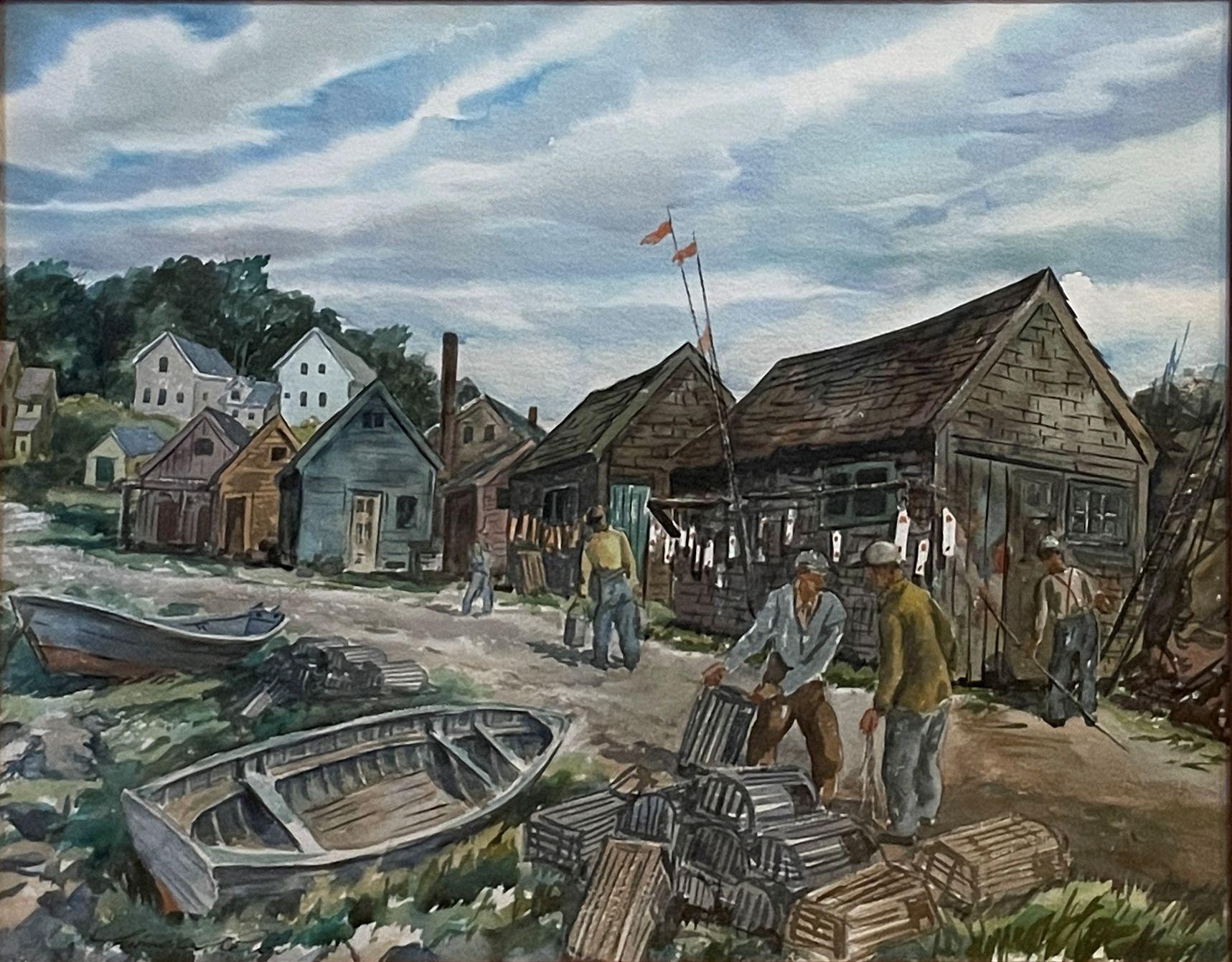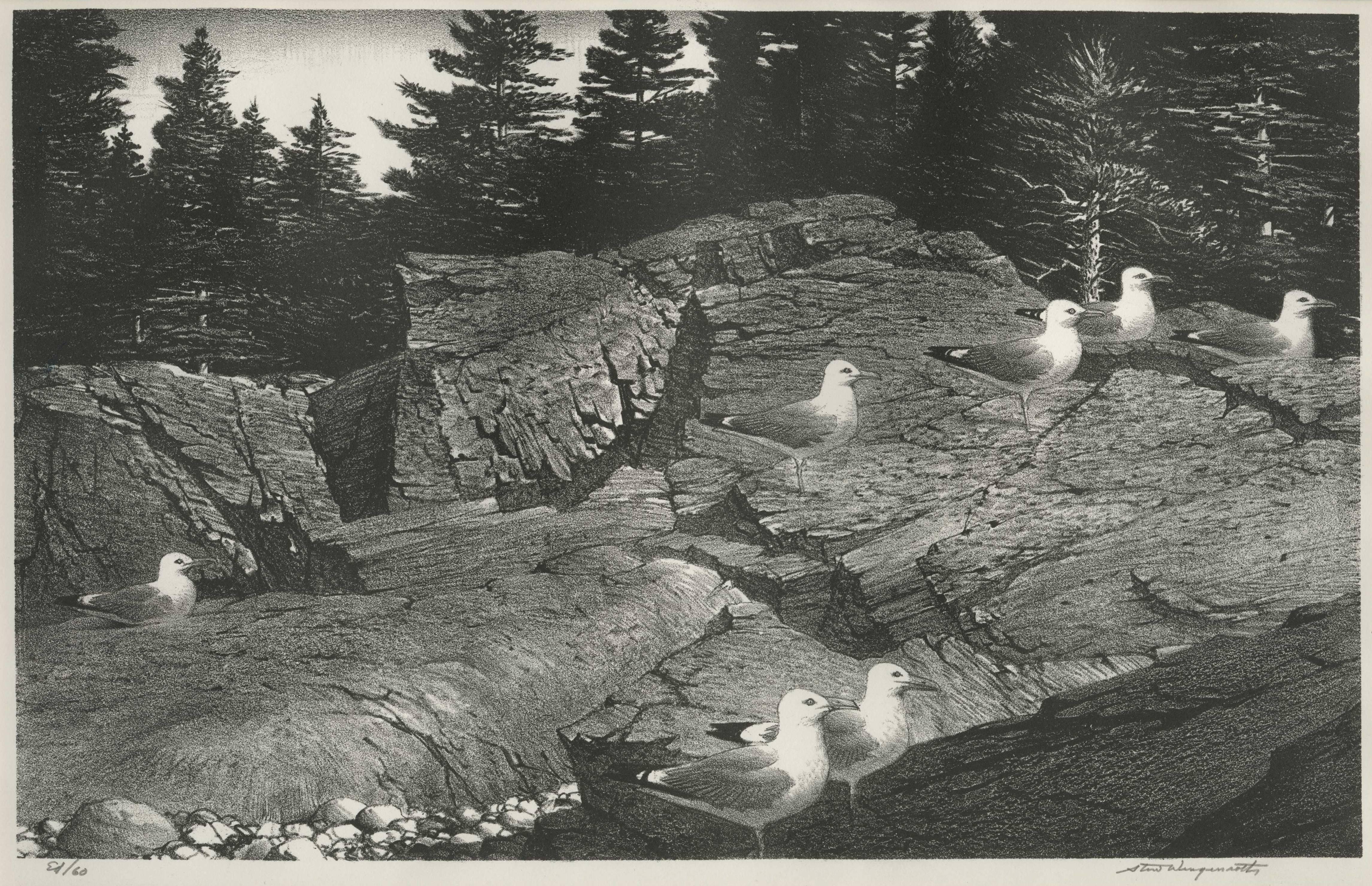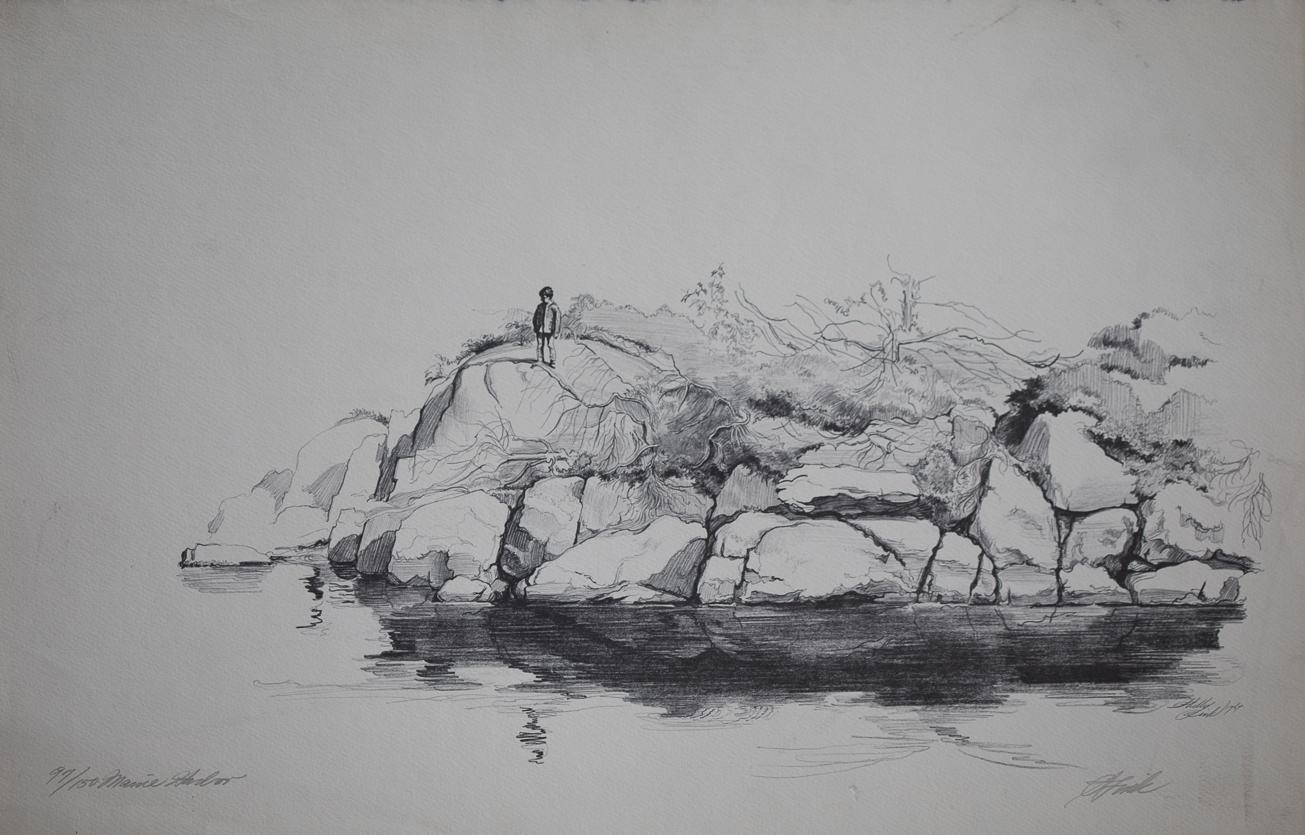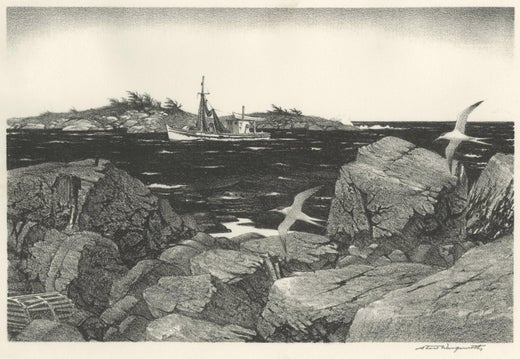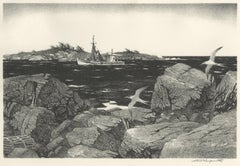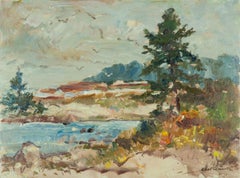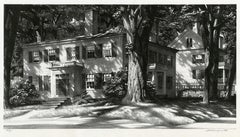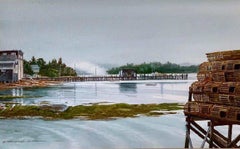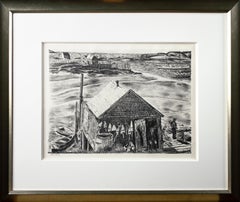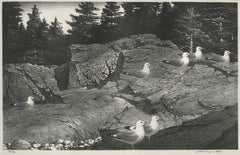Items Similar to Lobsterman's Cove, Winter Harbor, Maine
Want more images or videos?
Request additional images or videos from the seller
1 of 11
Stow WengenrothLobsterman's Cove, Winter Harbor, Maine1941
1941
$1,200
£906.80
€1,047.13
CA$1,676.82
A$1,860.57
CHF 974.61
MX$22,815.60
NOK 12,396.67
SEK 11,701.93
DKK 7,809.12
Shipping
Retrieving quote...The 1stDibs Promise:
Authenticity Guarantee,
Money-Back Guarantee,
24-Hour Cancellation
About the Item
Lobsterman's Cove, Winter Harbor, Maine
Lithograph, 1941
Signed in pencil lower right (see photo)
Edition 50
Impressions are in the collection of the Pennsylvania Academy of the Fine ARts, National Gallery of Art, Tale Univeristy, Farnsworth Art Museum,
Condition: See detail photo
Masking tape along the top martin edge 5 3/4" long
Very slight sun staining
Very rich impression with good contrasts
Image size: 12 9/16 x 16 5/8 inches
Sheet size: 16 5/8 x 18 7/8 inches
Reference: Stuckey 112
Stow Wengenroth (1906-1978)
"Stow Wengenroth, painter and lithographer, was born in Brooklyn, New York on July 25, 1906. Known for his realistic New England coastal scenes, landscapes, and still lifes, Wengenroth distinguished himself in the field of lithography and authored Making a Lithograph in 1936.
His art studies began at the Art Students' League in New York City in 1923 where he was a pupil of George Bridgman until 1925. From 1925 to 1927, he studied at the Grand Central School of Art under Wayman Adams.
Wengenroth was a member of the National Institute of Arts and Letters, the Providence Watercolor Club, the Connecticut Academy of Fine Arts, the Salmagundi Club in New York City, the Prairie Printmakers, and the Philadelphia Watercolor Club. He became an Associate of the National Academy of Design in 1938 and was elected to full Academician in 1941.
His exhibitions and awards include the Eyre gold medal, an honorable mention and other prizes, at the Philadelphia Print Club in 1934, 1935, 1937, and 1939; the Samuel Shaw prize at the Salmagundi Club in 1937; a prize at the American Artists for Victory, New York City, in 1942; a prize for black & white at the National Art Club, New York City, in 1933; a prize at the Northwest Printmakers in 1943; a prize at the Connecticut Academy of Fine Art Arts in 1943 and 1946; a prize at the Mint Museum of Art in 1944; a gold medal at the Philadelphia Watercolor Club in 1933 and 1943; and a gold medal at the Audubon Artists, New York City, in 1945.
Wengenroth's work is represented in the collections of the Addison Gallery of American Art in Andover, the Syracuse Museum of Fine Arts, the Baltimore Museum of Art, the Library of Congress, the New York Public Library, the Whitney Museum of American Art, the Denver Art Museum, the Milwaukee Art Museum, the Los Angeles Museum of Art, the Seattle Art Museum, the Fogg Museum of Art, the Boston Museum of Fine Arts, the Pennsylvania Academy of Fine Arts, the Metropolitan Museum of Art, the Carnegie Institute, the Indianapolis Museum of Art, the Butler Museum of American Art and the San Diego Museum of Art.
Wengenroth died in Rockport, Massachusetts on January 22, 1978." Courtesy Annex Galleries
- Creator:Stow Wengenroth (1906 - 1978, American)
- Creation Year:1941
- Dimensions:Height: 12.57 in (31.93 cm)Width: 16.63 in (42.25 cm)
- Medium:
- Movement & Style:
- Period:
- Condition:
- Gallery Location:Fairlawn, OH
- Reference Number:Seller: FA124891stDibs: LU14015440082
Stow Wengenroth
Born in Brooklyn in 1906, New York, Stow Wengenroth studied at the Art Students League of New York and Grand Central School of Art. He lived and worked for many years on Long Island and then moved to Rockport, Massachusetts. Wengenroth is renowned for his carefully wrought scenes of the New England seacoast like craggy rocks, lighthouses, boats and the sea. He died in 1978 in Rockport.
About the Seller
5.0
Recognized Seller
These prestigious sellers are industry leaders and represent the highest echelon for item quality and design.
Gold Seller
Premium sellers maintaining a 4.3+ rating and 24-hour response times
Established in 1978
1stDibs seller since 2013
796 sales on 1stDibs
Typical response time: 1 hour
Associations
International Fine Print Dealers Association
- ShippingRetrieving quote...Shipping from: Akron, OH
- Return Policy
Authenticity Guarantee
In the unlikely event there’s an issue with an item’s authenticity, contact us within 1 year for a full refund. DetailsMoney-Back Guarantee
If your item is not as described, is damaged in transit, or does not arrive, contact us within 7 days for a full refund. Details24-Hour Cancellation
You have a 24-hour grace period in which to reconsider your purchase, with no questions asked.Vetted Professional Sellers
Our world-class sellers must adhere to strict standards for service and quality, maintaining the integrity of our listings.Price-Match Guarantee
If you find that a seller listed the same item for a lower price elsewhere, we’ll match it.Trusted Global Delivery
Our best-in-class carrier network provides specialized shipping options worldwide, including custom delivery.More From This Seller
View AllNew England Coast (Greenport, New York)
By Stow Wengenroth
Located in Fairlawn, OH
New England Coast (Greenport, New York)
Lithograph, 1969
Signed in pencil lower right (see photo)
Edition: 350
Published in the book, Stow Wengenroth's New York, 1969
Limited slipcas...
Category
1960s American Realist Landscape Prints
Materials
Lithograph
On-coming Tide, Winter Harbor, Maine
Located in Fairlawn, OH
On-coming Tide, Winter Harbor, Maine
Oil on artist's board, 1971
Signed lower right
Signed, titled, and dated verso
Provenance: Estate of the Artist
Condition: Excellent
Need a ...
Category
1970s American Impressionist Landscape Paintings
Materials
Oil
Summer Shadows, Wiscasset, Maine
By Stow Wengenroth
Located in Fairlawn, OH
Summer Shadows, Wiscasset, Maine
Lithograph, 1947
Signed in pencil lower right (see photo)
"Ed. 85" lower left corner (see photo)
Edition: 85
Wiscasset, known as the "prettiest villa...
Category
1940s American Realist Landscape Prints
Materials
Lithograph
Outgoing Fog (South Bristol, Maine)
Located in Fairlawn, OH
Watercolor on paper, 1976
Painted in South Bristol, Maine
Signed by the artist lower left
Condition: Excellent
Category
1970s Realist Landscape Drawings and Watercolors
Materials
Watercolor
Gaspe: St. Lawrence Village
By William Grauer
Located in Fairlawn, OH
Signed by the artist in pencil, lower right
Provenance:
Estate of the Artist
With the artist's original presentation (Frame and matting)
Two similar titles were exhibited in The ...
Category
1950s American Modern Landscape Drawings and Watercolors
Materials
Watercolor
Gaspe: St. Lawrence Village
By William Grauer
Located in Fairlawn, OH
Signed by the artist in pencil, lower right
Provenance:
Estate of the Artist
With the artist's original presentation (Frame and matting)
Two similar titles were exhibited in The ...
Category
1950s American Modern Landscape Drawings and Watercolors
Materials
Watercolor
You May Also Like
'Lobsterman's Wharf, Maine' original lithograph signed by "Zsissly" Albright
By Malvin Marr Albright
Located in Milwaukee, WI
'Lobsterman's Wharf, Maine' is an original lithograph signed by Malvin Marr "Zsissly" Albright. While Malvin Marr – along with his better-known identical twin Ivan Albright – was known for his meticulous and unsettling magic realist compositions, he and his brother were also prolific in capturing landscapes of the coast of Maine where the two spent several consecutive summers away from Chicago over their lives. Sometimes these Maine landscapes and views would be painterly and seemingly antithetical to the careful realism of his other work; but in this example, however, the wharf is treated with the same macabre decay as his human subjects. In the composition, the shack...
Category
1940s American Modern Figurative Prints
Materials
Lithograph
Nautical New England Realist Painting
Located in Wilton Manors, FL
Beautiful seaside boathouse painting by Franklin Shores (1942-2020).
Watercolor on rag paper measuring 22 x 29 inches.
Signed lower right. Excellent condition.
Provenance: Collec...
Category
1970s Realist Landscape Paintings
Materials
Archival Paper, Watercolor
"Lobstermen in Gloucester, Mass." Lionel Reiss WPA Social Realism Fishermen
By Lionel S. Reiss
Located in New York, NY
Lionel S. Reiss (1894 - 1988)
Lobstermen in Gloucester, Massachusetts, circa 1943
Watercolor on paper
Sight 17 1/2 x 23 inches
Signed lower left
Provenance:
Private Collection, Las Vegas, Nevada
In describing his own style, Lionel Reiss wrote, “By nature, inclination, and training, I have long since recognized the fact that...I belong to the category of those who can only gladly affirm the reality of the world I live in.” Reiss’s subject matter was wide-ranging, including gritty New York scenes, landscapes of bucolic Bucks County, Pennsylvania, and seascapes around Gloucester, Massachusetts. However, it was as a painter of Jewish life—both in Israel and in Europe before World War II—that Reiss excelled. I.B. Singer, the Nobel Prize winner for Literature, noted that Reiss was “essentially an artist of the nineteenth century, and because of this he had the power and the courage to tell visually the story of a people.”
Although Reiss was born in Jaroslaw, Poland, his family immigrated to the United States in 1898 when he was four years old. Reiss's family settled on New York City’s Lower East Side and he lived in the city for most of his life. Reiss attended the Art Students League and then worked as a commercial artist for newspapers and publishers. As art director for Metro-Goldwyn-Mayer, he supposedly created the studio’s famous lion logo.
After World War I, Reiss became fascinated with Jewish life in the ‘Old World.’ In 1921 he left his advertising work and spent the next ten years traveling in Europe, the Middle East, and North Africa. Like noted Jewish photographers Alter Kacyzne and Roman Vishniac, Reiss depicted Jewish life in Poland prior to World War II. He later wrote, “My trip encompassed three main objectives: to make ethnic studies of Jewish types wherever I traveled; to paint and draw Jewish life, as I saw it and felt it, in all aspects; and to round out my work in Israel.”
In Europe, Reiss recorded quotidian scenes in a variety of media and different settings such as Paris, Amsterdam, the Venice ghetto, the Jewish cemetery in Prague, and an array of shops, synagogues, streets, and marketplaces in the Jewish quarters of Warsaw, Lodz, Krakow, Lublin, Vilna, Ternopil, and Kovno. He paid great attention to details of dress, hair, and facial features, and his work became noted for its descriptive quality.
A selection of Reiss’s portraits appeared in 1938 in his book My Models Were Jews. In this book, published on the eve of the Holocaust, Reiss argued that there was “no such thing as a ‘Jewish race’.” Instead, he claimed that the Jewish people were a cultural group with a great deal of diversity within and between Jewish communities around the world. Franz Boas...
Category
1940s American Realist Landscape Paintings
Materials
Paper, Watercolor
Shoreline, Greenport, New York
By Stow Wengenroth
Located in Boston, MA
Stuckey 328. From an edition of 60. Signed in pencil lower right margin: "Stow Wengenroth"; inscribed in pencil lower left margin: "Ed/60". A fine impression in fine condition. Sheet...
Category
20th Century Realist Landscape Prints
Materials
Lithograph
Maine Harbor
By Shelly Fink
Located in New York, NY
Sheldon Fink (American, 1925-2002), "Maine Harbor" Edition of 150, Lithograph signed on Paper, 14 x 17, Late 20th Century, 1960s
Depicts boy standing on r...
Category
1960s American Realist Portrait Prints
Materials
Lithograph
'Gloucester Harbor' — Mid-Century Cape Ann Regionalism
Located in Myrtle Beach, SC
Lawrence Nelson Wilbur, 'Gloucester Harbor', drypoint, 1940. Signed, dated, and titled in pencil. Signed in the plate, lower right. Annotated 'PERSONAL...
Category
1940s American Realist Landscape Prints
Materials
Drypoint
$520 Sale Price
20% Off
More Ways To Browse
Orchard By David Harrison
Paolo Boni
Pedro Lemos
Richard Giglio
Ronald Stephen Riddick
Roy Lichtenstein Sandwich And Soda
Salvador Dali Sun Goddess
Salvador Dali The Alps
Tarkay Giclee
Theodore Hancock
Vintage Breckenridge Posters
Waldo Chase
Alain Manesson Mallet On Sale
Alain Moulis
Alicia Rhett
Bernard Buffet Place De La Concorde
Bernard Gantner Lithograph
Bernard Gantner On Sale
